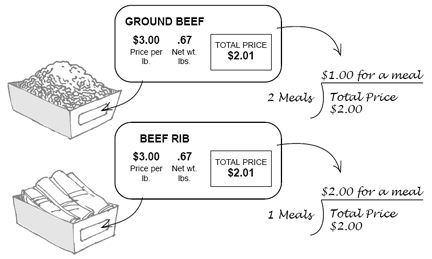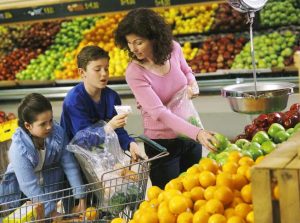Bulletin #4332, Buying Food for Thrifty Small Families
Thrifty Meals for Small Families
Originally prepared by Nellie Hedstrom, Extension nutrition specialist, University of Maine Cooperative Extension.
Revised and updated by Statewide Nutrition and Physical Activity Educator Kate Yerxa, University of Maine Cooperative Extension.
For information about UMaine Extension programs and resources, visit extension.umaine.edu.
Find more of our publications and books at extension.umaine.edu/publications/.
Once you have planned your menus and made a shopping list, you’re ready to shop. The prices you pay will depend on where and how you shop. It takes time and effort to become a food buying expert. But it’s well worth it. To make your food dollars count,
- decide where and how often to shop;
- compare process and products while you shop;
- keep your shopping skills current and know your prices.
Buying tips when shopping for bread, cereal, rice, and pasta:
- Choose whole-grain or enriched products for good nutrition.
- Buy hot and cold cereals in large boxes instead of small, individual packages. Individual packages and instant types cost more than twice as much per serving.
- Look for bargains on day-old bread and bakery products.
- Add your own seasonings and sauces to rice and pasta.
- Buy cereals plain, without added sugar.
Buying tips when shopping for milk, cheese, and yogurt:
- Select the largest container you can use without waste. Larger containers are usually less expensive.
- Grate cheese yourself. Packages of shredded cheese cost more than the same amount of cheese in wedges or blocks.
- Check the dates on the packages—see the definition of the dates on packages below.
Buying tips when shopping for vegetables and fruits:
- Watch for good buys on fresh fruits and vegetables in season.
- Buy plain canned or plain frozen vegetables instead of those with added seasonings and sauces or vegetables in microwave packaging.
- Look for large bags of frozen vegetables. They may be bargains, and you can pour out the exact amount you need.
| Season | Fruit |
| Spring | rhubarb |
| Summer | apples, blackberries, blueberries, pears, plums, raspberries, blueberries, strawberries, watermelon/cantaloupe |
| Fall | apples, cranberries, grapes, pears, raspberries |
| Winter | Apples (check freezer sections at stores for Maine-grown fruits, including blueberries and cranberries) |
| Season | Vegetable |
| Spring | asparagus, dry beans, lettuce/mixed greens, beet greens, scallions, radishes, spinach |
| Summer | beans (snap, wax), beets, beet greens, broccoli, cabbage, carrots, cauliflower, sweet corn, cucumbers, dry beans, eggplant, garlic, kale/collards/swiss chard, leeks, lettuce/mixed greens, onions, scallions, peas, pea pods, peppers, potatoes, radishes, spinach, summer squash, tomatoes, turnips |
| Fall | beets, beet greens, broccoli, Brussels sprouts, cabbage, carrots, cauliflower, dry beans, garlic, kale/collards/swiss chard, leeks, lettuce/mixed greens, onions, parsnips, peppers, potatoes, pumpkins, rutabagas, spinach, winter squash, tomatoes, turnips |
| Winter | beets, cabbage, cabbage, carrots, dry beans, garlic, onions, parsnip, potatoes, pumpkins, tomatoes, winter squash |
Adapted from Seasonal Availability of Maine Fresh Fruits and Vegetables. Augusta: Maine Department of Agriculture, Food & Rural Resources
Buying tips when shopping for meat, poultry, fish, eggs, dry beans, and nuts:
- Look for specials at the meat counter. Buying sale cuts can mean big savings for you. Some higher-priced meats may fit your budget when they are on sale.
- Cut up meats and chicken yourself. For example, stew meat usually costs more than a chuck roast. You can cut the roast into cubes and save money. Chicken pieces often cost more than whole chickens, too.
- For convenience, buy larger amounts of meats when it is on sale and repackage into smaller packages and freeze for later use. Use only what you need, and keep the remainder frozen until you need them.
The following foods not only cost more, but will increase the fat, sugar, and salt in your diet:
- Frozen vegetables with seasonings and sauces
- Out-of-season fresh fruits and vegetables
- Ready-made or ready-to-bake cookies, cakes, pies, and buns
- Sugar-coated cereals
- Cream, ice cream, cream cheese, yogurt, and specialty cheeses
- Many ready-to-eat dishes
- Some cuts of meats, poultry, and fish
- Snack foods, such as potato or corn chips
- Soda and sugar sweetened beverages
Take Care to Check Dates
The “Pull By” or “Sell by” date
This is the last day a food item can be sold. After this date the store must pull it from the shelves. Food products are still safe to eat for a few days after this date. This date is used for food products like milk, cheese, and meats.
The “Best By” date
This is the last day a food product will be at its best. After this date, food is past its peak but is still safe to eat. Dry cereal that has turned stale is an example of this. Breakfast cereals and baked goods use this type of date.
The “Expiration” or “Use By” date
This is the last day a food product is safe to eat. Never eat food past its “expiration” or “use by” date. Instead, this food should be thrown away. You can find this kind of date on cold food items: salad dressings, milk and eggs are examples.
The “Pack” date
This is the date a food item was packaged. Foods that stay fresh for long lengths use this date. Canned goods, like veggies, are an example. Never use food from dented, leaking, or bulging cans. This food is not safe to eat.
Compare the Cost of a Meal or a Serving
Some foods have parts you can’t eat—like the bone and fat in meat or the cores, pits or peels of fresh fruits and vegetables. For these foods, the lowest price per pound isn’t always the best buy. To find the best buy, you need to compare the costs of the amounts you need for a meal or for a serving.
From past experience, you probably know how much of these foods you need for a meal. To find the cost of a meal,
- first, think of how many meals a package will serve;
- then divide the number of meals you expect to get into the price for the package. This gives you the cost per meal.
The example below shows how to compare costs for meats.
At the meat counter:
Compare the cost of a meal. Which is the better buy?

Ground beef is the better buy at $1.00 for a meal.
For some foods—especially fruits—it may be easier to compare the cost of a serving than the cost of a meal. To find the cost of a serving,
- first, think of the number of servings you can get from a market unit—such as a pound of bananas, five grapefruit or one pineapple;
- then, divide the number of servings into the price for the market unit to find the cost of a serving.
The example below shows how to compare costs for fresh fruits.
In the produce section:
Compare the cost for a serving. Which of the following three is the better buy?

Bananas at 1 pound for 60¢ and grapefruits at 2 for $1.00 are the better buys.
Read Food Labels
Food labels can tell you a lot about what’s inside the package. To see what you are really paying for, read the label.
- Look for the list of ingredients. Ingredients are listed on the package in order from largest to smallest amounts.
- Look to see if breads, bakery products, rice, flour and pasta are whole-grain or enriched. “Whole-grain” flour still has most of the nutrients that were originally in the wheat or other grain. In making white flour, however, some of those nutrients are lost. “Enriched” means that those nutrients have been put back. Sometimes, you can tell if a food is whole-grain from its name. For other foods, you’ll need to look at the ingredient list.
Keep Your Shopping Skills Current
Be alert to the ways foods are displayed. Watch out for foods placed at the end of the aisle or in an attractive display. If it is not on your list, don’t buy it! They may not really be bargains. Be careful using “cents-off” coupons, too. Often these coupons are for name brand products that cost more than the store brand products, even with the coupon discount. Be sure to compare costs!
See the other bulletins in the Thrifty Meals for Small Families series:
- Planning Thrifty Meals for Small Families (#4330)
- Ideas for Planning Thrifty Menus (#4331)
- Thrifty Recipes: Main Dishes (#4333)
- Thrifty Recipes: Salads and Soups, Breads and Desserts (#4334)
Originally adapted from “Thrifty Meals for Two: Making Food Dollars Count,” USDA Home and Garden Bulletin #244.
Information in this publication is provided purely for educational purposes. No responsibility is assumed for any problems associated with the use of products or services mentioned. No endorsement of products or companies is intended, nor is criticism of unnamed products or companies implied.
© 2003, 2010
Call 800.287.0274 (in Maine), or 207.581.3188, for information on publications and program offerings from University of Maine Cooperative Extension, or visit extension.umaine.edu.
The University of Maine is an EEO/AA employer, and does not discriminate on the grounds of race, color, religion, sex, sexual orientation, transgender status, gender expression, national origin, citizenship status, age, disability, genetic information or veteran’s status in employment, education, and all other programs and activities. The following person has been designated to handle inquiries regarding non-discrimination policies: Sarah E. Harebo, Director of Equal Opportunity, 101 North Stevens Hall, University of Maine, Orono, ME 04469-5754, 207.581.1226, TTY 711 (Maine Relay System).


